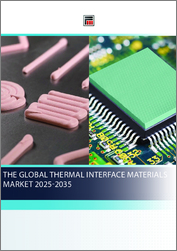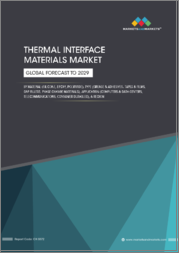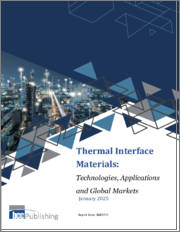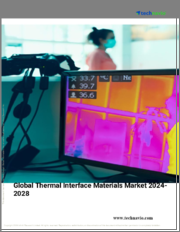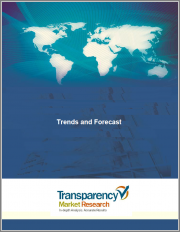
|
시장보고서
상품코드
1715691
세계의 열 인터페이스 재료 시장 : 제품, 재료, 용도별 - 예측(2025-2030년)Thermal Interface Materials Market by Product, Material, Application - Global Forecast 2025-2030 |
||||||
열 인터페이스 재료 시장은 2024년에 42억 7,000만 달러로 평가되었습니다. 2025년에는 46억 4,000만 달러에 이르고, CAGR 9.00%로 성장하여 2030년에는 71억 6,000만 달러에 달할 것으로 예측됩니다.
| 주요 시장 통계 | |
|---|---|
| 기준 연도 : 2024년 | 42억 7,000만 달러 |
| 추정 연도 : 2025년 | 46억 4,000만 달러 |
| 예측 연도 : 2030년 | 71억 6,000만 달러 |
| CAGR(%) | 9.00% |
열 인터페이스 재료(TIM)는 다양한 산업에서 최적의 열 관리를 보장하기 위한 핵심 부품으로 부상하고 있습니다. 오늘날의 급변하는 기술 환경에서 전자, 산업기계 및 자동차 시스템을 안전한 작동 온도로 유지하는 것은 단순한 기술적 과제가 아니라 효율성, 신뢰성 및 전반적인 성능을 향상시키기 위한 핵심 과제가 되었습니다. 이 분야 시장 역학은 재료 과학의 발전과 고성능 전자기기에 대한 수요 증가에 힘입어 빠르게 진화하고 있습니다. 최신 디바이스의 소형화 및 처리 능력이 향상됨에 따라 열 관리 분야의 혁신적인 솔루션에 대한 필요성이 그 어느 때보다 높아지고 있습니다.
이 종합적인 분석은 TIM 시장을 형성하는 다양한 요인을 심층적으로 분석합니다. TIM의 진화를 살펴봄으로써 독자들은 현재 동향이 어떻게 이러한 재료가 달성할 수 있는 한계에 계속 도전하고 있는지 명확하게 이해할 수 있으며, 이를 통해 다양한 응용 분야에서 지속 가능한 성장과 기술 혁신을 위한 발판을 마련할 수 있습니다. 다양한 응용 분야에서 지속적인 성장과 기술적 돌파구를 마련할 수 있는 발판을 마련할 수 있습니다.
열 인터페이스 재료 시장의 변화
열 관리 산업은 TIMs 시장 상황을 재정의하는 변화의 시기를 맞이하고 있습니다. 재료 공학의 급속한 기술 혁신은 보다 효율적이고 내구성이 뛰어나며 첨단 전자 기기 및 기타 고성능 용도의 까다로운 요구 사항에 적응할 수 있는 열 솔루션의 길을 열었습니다. 기존 재료는 우수한 방열 특성, 내열성, 기계적 유연성을 갖춘 새로운 화합물에 의해 보완되고 있습니다.
또 다른 큰 변화의 원동력은 TIM이 중요한 역할을 하는 응용 분야가 급증하고 있다는 점입니다. 자동차, 가전, 항공우주 등의 산업에서는 가혹한 조건에서 엄격한 성능 기준을 충족하는 재료가 요구되고 있습니다. 이러한 조건에서는 TIM의 구성과 가공을 개선하여 스트레스 하에서 성능을 발휘할 뿐만 아니라 TIM이 지원하는 장치의 수명을 연장할 수 있도록 보장해야 합니다. 또한, 에너지 효율과 지속가능성에 대한 강조로 인해 연구개발에 대한 투자가 확대되고 있으며, 제조업체들은 열전도율을 최대화하면서 에너지 손실을 최소화하는 구성 및 통합 기술 개선을 지속적으로 추구하고 있습니다.
이러한 진화는 업계 이해관계자 및 학계와의 협력관계 강화로 뒷받침되고 있으며, 그 결과 첨단 기술의 상용화가 가속화되고 혁신을 창출할 수 있는 환경이 조성되고 있습니다.
열 인터페이스 재료의 주요 부문 분석
면밀한 세분화 분석을 통해 열 인터페이스 재료 시장이 어떻게 다각적으로 세분화되어 있는지, 그리고 각 부문이 소비자 요구와 제품 성능에 대한 명확한 통찰력을 제공하는지 확인했습니다. 제품별로 평가하면 젤, 그리스, 패드, 열접착제, 열 테이프 등 다양한 제품을 통해 시장을 조사할 수 있습니다. 각 제품 유형은 특정 열 관리 요구 사항 및 운영 환경에 대응하며, 용도의 미묘한 차이를 강조합니다. 마찬가지로, 아크릴, 에폭시, 폴리이미드, 실리콘과 같은 주요 재료가 많은 혁신적인 TIM 솔루션의 구성 요소인 재료별로 시장을 분석합니다. 재료의 선택은 열 전달 능력뿐만 아니라 열 인터페이스의 수명과 열악한 조건에서 열 인터페이스의 응답성에도 큰 영향을 미칩니다.
또한, 시장을 용도별로 분류하면 항공우주 및 방위, 자동차, 가전, 산업기계, 의료기기, 통신 등 다양한 분야에 걸쳐 조사됩니다. 이러한 구분은 다양한 산업이 어떻게 고유한 성능과 내구성을 요구하는지에 대한 통찰력을 제공하여 제품 개발 및 시장 전략에 영향을 미칠 수 있습니다. 이러한 다층적 세분화의 수렴은 시장 동향에 대한 종합적인 이해를 촉진하고, 이해관계자들이 기술 혁신의 기회를 포착하고 미묘한 산업 수요에 대응할 수 있도록 돕습니다.
목차
제1장 서문
제2장 조사 방법
제3장 주요 요약
제4장 시장 개요
제5장 시장 인사이트
- 시장 역학
- 성장 촉진요인
- 성장 억제요인
- 기회
- 해결해야 할 과제
- 시장 세분화 분석
- Porter’s Five Forces 분석
- PESTLE 분석
- 정치
- 경제
- 사회
- 기술
- 법률
- 환경
제6장 열 인터페이스 재료 시장 : 제품별
- 겔
- 그리스
- 패드
- 열 접착제
- 서멀 테이프
제7장 열 인터페이스 재료 시장 : 소재별
- 아크릴
- 에폭시
- 폴리이미드
- 실리콘
제8장 열 인터페이스 재료 시장 : 용도별
- 항공우주 및 방위
- 자동차
- 가전
- 산업기계
- 의료기기
- 통신
제9장 아메리카의 열 인터페이스 재료 시장
- 아르헨티나
- 브라질
- 캐나다
- 멕시코
- 미국
제10장 아시아태평양의 열 인터페이스 재료 시장
- 호주
- 중국
- 인도
- 인도네시아
- 일본
- 말레이시아
- 필리핀
- 싱가포르
- 한국
- 대만
- 태국
- 베트남
제11장 유럽, 중동 및 아프리카의 열 인터페이스 재료 시장
- 덴마크
- 이집트
- 핀란드
- 프랑스
- 독일
- 이스라엘
- 이탈리아
- 네덜란드
- 나이지리아
- 노르웨이
- 폴란드
- 카타르
- 러시아
- 사우디아라비아
- 남아프리카공화국
- 스페인
- 스웨덴
- 스위스
- 튀르키예
- 아랍에미리트(UAE)
- 영국
제12장 경쟁 구도
- 시장 점유율 분석, 2024
- FPNV 포지셔닝 매트릭스, 2024
- 경쟁 시나리오 분석
- 전략 분석과 제안
기업 리스트
- 3M Company
- Altana AG
- Amogreentech Co., Ltd.
- Boyd Corporation
- DuPont de Nemours, Inc.
- Electrolube Limited by MacDermid Alpha Electronics Solutions
- European Thermodynamics Ltd.
- Fuji Polymer Industries Co., Ltd.
- Heico Companies LLC
- Henkel AG & Co. KGaA
- Honeywell International Inc.
- Indium Corporation
- Master Bond Inc.
- Meridian Adhesives Group LLC
- Minerals Technologies Inc.
- Momentive Inc.
- Panasonic Holdings Corporation
- Parker Hannifin Corporation
- Semikron Danfoss International GmbH
- Shin-Etsu Chemical Co., Ltd.
- T-Global Technology Ltd.
- Techsil Limited by Diploma PLC
- The Dow Chemical Company
The Thermal Interface Materials Market was valued at USD 4.27 billion in 2024 and is projected to grow to USD 4.64 billion in 2025, with a CAGR of 9.00%, reaching USD 7.16 billion by 2030.
| KEY MARKET STATISTICS | |
|---|---|
| Base Year [2024] | USD 4.27 billion |
| Estimated Year [2025] | USD 4.64 billion |
| Forecast Year [2030] | USD 7.16 billion |
| CAGR (%) | 9.00% |
Thermal Interface Materials (TIMs) have emerged as a critical component in ensuring optimal thermal management across a range of industries. In today's fast-paced technology landscape, keeping electronic devices, industrial machinery, and automotive systems at safe operating temperatures is not merely a technical challenge-it is central to enhancing efficiency, reliability, and overall performance. The market dynamics in this sector are evolving rapidly, fueled by advancements in material science and increased demand driven by high-performance electronics. As modern devices become more compact while simultaneously intensifying their processing capabilities, the need for innovative solutions in thermal management is more pronounced than ever.
This comprehensive analysis delves into the various factors that are shaping the TIM market. It highlights not only the technical innovations but also the economic drivers and regional considerations that are influencing product design and material selection. By exploring the evolution of TIMs, readers can gain a clear understanding of how current trends continue to push the boundaries of what these materials can achieve, thereby setting the stage for sustained growth and technological breakthroughs in diverse applications.
Transformative Shifts in the Thermal Interface Materials Landscape
The thermal management industry is experiencing transformative shifts that are redefining the market landscape for TIMs. Rapid innovation in materials engineering has paved the way for thermal solutions that are more efficient, durable, and adaptable to the rigorous demands of advanced electronic devices and other high-performance applications. Traditional materials are now increasingly complemented by novel compounds that offer superior heat dissipation properties, increased resistance to thermal degradation, and greater mechanical flexibility.
Another significant driver of change is the surge in application areas where TIMs are crucial. Industries such as automotive, consumer electronics, and aerospace now demand materials that can meet strict performance criteria under extreme conditions. These conditions have necessitated improvements in the composition and processing of TIMs, ensuring that they not only perform under stress but also extend the lifespan of the devices they support. Additionally, the focus on energy efficiency and sustainability has led to greater investment in research and development, with manufacturers continuously seeking to refine compositions and integration techniques that minimize energy losses while maximizing thermal conductivity.
This evolution is underpinned by increased collaboration between industry stakeholders and academic institutions, resulting in faster commercialization of advanced technologies and creating an environment ripe for innovation.
Key Segmentation Insights in Thermal Interface Materials
An in-depth segmentation analysis reveals how the thermal interface materials market is dissected along multiple dimensions, each offering distinct insights into consumer needs and product performance. When evaluated on the basis of product, the market is studied through an array of offerings including gels, greases, pads, thermal adhesive, and thermal tapes. Each product type caters to specific thermal management requirements and operational environments, highlighting subtle differences in their applications. Similarly, the market is analyzed by material, where key materials such as acrylic, epoxy, polyimide, and silicone serve as the building blocks for many innovative TIM solutions. The choice of material significantly impacts not only heat transfer capabilities but also the longevity and response of the thermal interface under challenging conditions.
Furthermore, when segmenting by application, the market is studied across sectors including aerospace and defense, automotive, consumer electronics, industrial machinery, medical devices, and telecommunications. This delineation provides insights into how different industries have unique performance and durability requirements, influencing both product development and market strategies. The convergence of these multiple layers of segmentation facilitates a comprehensive understanding of market trends, enabling stakeholders to pinpoint opportunities for innovation and cater to nuanced industry demands.
Based on Product, market is studied across Gels, Greases, Pads, Thermal Adhesive, and Thermal Tapes.
Based on Material, market is studied across Acrylic, Epoxy, Polyimide, and Silicone.
Based on Application, market is studied across Aerospace & Defense, Automotive, Consumer Electronics, Industrial Machinery, Medical Devices, and Telecommunications.
Key Regional Insights: A Global Perspective
The global landscape for thermal interface materials is characterized by pronounced regional variations that reflect differences in industrial growth, technological adoption, and regulatory environments. The Americas have witnessed robust demand spurred by high-volume manufacturing in sectors like consumer electronics and automotive, where the emphasis is on reliable, high-performance thermal management to support technologically advanced systems. In Europe, the Middle East, and Africa, regulatory frameworks along with significant investment in research are driving innovation in TIM technology, particularly in the industrial and defense sectors. These regions are focused on maintaining competitive advantages while ensuring compliance with rigorous quality standards.
Asia-Pacific is perhaps the most dynamic of all regions, with rapid industrialization and an accelerating setup of manufacturing hubs fostering a fertile environment for innovation. The region is not only a major production center for electronic devices but also a key consumer of advanced thermal solutions that are integral to next-generation products. Increased R&D budgets, coupled with a high degree of technology integration across multiple industries, have bolstered the adoption of state-of-the-art thermal interface materials. Observing these regional distinctions, it becomes clear how geographical market drivers influence both supply chain dynamics and technology trends in the TIM sector.
Based on Region, market is studied across Americas, Asia-Pacific, and Europe, Middle East & Africa. The Americas is further studied across Argentina, Brazil, Canada, Mexico, and United States. The United States is further studied across California, Florida, Illinois, New Jersey, New York, North Carolina, Ohio, Pennsylvania, and Texas. The Asia-Pacific is further studied across Australia, China, India, Indonesia, Japan, Malaysia, Philippines, Singapore, South Korea, Taiwan, Thailand, and Vietnam. The Europe, Middle East & Africa is further studied across Denmark, Egypt, Finland, France, Germany, Israel, Italy, Netherlands, Nigeria, Norway, Poland, Qatar, Russia, Saudi Arabia, South Africa, Spain, Sweden, Switzerland, Turkey, United Arab Emirates, and United Kingdom.
Key Company Insights Driving Market Innovation
Market innovation in thermal interface materials is propelled by a range of key companies that are known for their technological expertise and ability to meet evolving market demands. Industry giants such as 3M Company and DuPont de Nemours, Inc. have long-established reputations for pushing the boundaries of material science, while companies like Altana AG and Amogreentech Co., Ltd. bring specialized expertise to niches in thermal management. Corporations such as Boyd Corporation and Electrolube Limited by MacDermid Alpha Electronics Solutions have made significant contributions in developing solutions that cater to specific industry segments.
Other notable market players, including European Thermodynamics Ltd., Fuji Polymer Industries Co., Ltd., and Heico Companies LLC, continuously explore new performance metrics to ensure their materials can be integrated across diverse applications. Henkel AG & Co. KGaA, Honeywell International Inc., and Indium Corporation are consistently at the forefront of applying new manufacturing techniques that enhance the reliability and efficiency of TIMs. Master Bond Inc., Meridian Adhesives Group LLC, and Minerals Technologies Inc. offer robust adhesion and thermal management solutions that have become essential in managing the thermal challenges of modern electronics. With Momentive Inc., Panasonic Holdings Corporation, and Parker Hannifin Corporation, the drive for improved thermal performance is matched by rigorous quality control and a strong focus on sustainability. Companies like Semikron Danfoss International GmbH, Shin-Etsu Chemical Co., Ltd., T-Global Technology Ltd., Techsil Limited by Diploma PLC, and The Dow Chemical Company round out the list of innovators who are instrumental in shaping industry standards and driving research into next-generation materials.
The report delves into recent significant developments in the Thermal Interface Materials Market, highlighting leading vendors and their innovative profiles. These include 3M Company, Altana AG, Amogreentech Co., Ltd., Boyd Corporation, DuPont de Nemours, Inc., Electrolube Limited by MacDermid Alpha Electronics Solutions, European Thermodynamics Ltd., Fuji Polymer Industries Co., Ltd., Heico Companies LLC, Henkel AG & Co. KGaA, Honeywell International Inc., Indium Corporation, Master Bond Inc., Meridian Adhesives Group LLC, Minerals Technologies Inc., Momentive Inc., Panasonic Holdings Corporation, Parker Hannifin Corporation, Semikron Danfoss International GmbH, Shin-Etsu Chemical Co., Ltd., T-Global Technology Ltd., Techsil Limited by Diploma PLC, and The Dow Chemical Company. Actionable Recommendations for Industry Leaders
For industry leaders aiming to capitalize on the shifting dynamics of the thermal interface materials market, a strategic blend of innovation, collaboration, and market intelligence is imperative. Leaders should invest in targeted R&D initiatives that focus on the development of hybrid materials and improved production methods. This will not only foster the creation of TIMs with superior thermal conductivity and prolonged durability but will also aid in meeting the growing environmental and energy efficiency mandates driven by global regulations.
It is essential for organizations to embrace cross-sector partnerships that leverage both academic insights and industrial expertise. Collaborative research projects and pilot programs can accelerate the time-to-market for advanced materials while providing critical feedback on product performance under diversified operating conditions. Additionally, maintaining an agile response system to not only foresee but respond to market fluctuations will be paramount. With the increasing adoption of digital tools, leaders are encouraged to use advanced analytics and real-time data monitoring to inform strategy and optimize supply chain management. Such proactive measures ensure that businesses stay ahead of the curve in a rapidly evolving marketplace.
Conclusion: Navigating the Road Ahead in TIM Innovation
In summary, the thermal interface materials market is undergoing significant transformation driven by rapid technological advancements and diversifying application demands. An integrated approach-one that combines nuanced product segmentation with a global view of regional dynamics-is critical for navigating this complex landscape. As companies innovate and adapt to meet the diverse thermal management needs across various industries, the importance of informed strategy and agile operational practices cannot be understated.
The challenges of managing thermal performance in an increasingly interconnected technological environment also bring with them unparalleled opportunities. By aligning product development strategies with rigorous market analysis and embracing collaborative efforts, industry leaders can secure competitive advantages and drive sustained growth in today's fast-moving market.
Table of Contents
1. Preface
- 1.1. Objectives of the Study
- 1.2. Market Segmentation & Coverage
- 1.3. Years Considered for the Study
- 1.4. Currency & Pricing
- 1.5. Language
- 1.6. Stakeholders
2. Research Methodology
- 2.1. Define: Research Objective
- 2.2. Determine: Research Design
- 2.3. Prepare: Research Instrument
- 2.4. Collect: Data Source
- 2.5. Analyze: Data Interpretation
- 2.6. Formulate: Data Verification
- 2.7. Publish: Research Report
- 2.8. Repeat: Report Update
3. Executive Summary
4. Market Overview
5. Market Insights
- 5.1. Market Dynamics
- 5.1.1. Drivers
- 5.1.1.1. Growing demand for consumer electronics globally
- 5.1.1.2. Rising awareness about energy conservation globally
- 5.1.1.3. Rapid expansion of the automotive industry
- 5.1.2. Restraints
- 5.1.2.1. High production costs associated with thermal interface materials
- 5.1.3. Opportunities
- 5.1.3.1. Expansion of the renewable energy sector
- 5.1.3.2. Expanding applications in the electric vehicle manufacturing sector
- 5.1.4. Challenges
- 5.1.4.1. Availability of alternative materials
- 5.1.1. Drivers
- 5.2. Market Segmentation Analysis
- 5.2.1. Product: Increasing adoption of thermal pads and greases for their balance of thermal conductivity
- 5.2.2. Application: Expanding application of thermal interface materials in aerospace & defense sector
- 5.3. Porter's Five Forces Analysis
- 5.3.1. Threat of New Entrants
- 5.3.2. Threat of Substitutes
- 5.3.3. Bargaining Power of Customers
- 5.3.4. Bargaining Power of Suppliers
- 5.3.5. Industry Rivalry
- 5.4. PESTLE Analysis
- 5.4.1. Political
- 5.4.2. Economic
- 5.4.3. Social
- 5.4.4. Technological
- 5.4.5. Legal
- 5.4.6. Environmental
6. Thermal Interface Materials Market, by Product
- 6.1. Introduction
- 6.2. Gels
- 6.3. Greases
- 6.4. Pads
- 6.5. Thermal Adhesive
- 6.6. Thermal Tapes
7. Thermal Interface Materials Market, by Material
- 7.1. Introduction
- 7.2. Acrylic
- 7.3. Epoxy
- 7.4. Polyimide
- 7.5. Silicone
8. Thermal Interface Materials Market, by Application
- 8.1. Introduction
- 8.2. Aerospace & Defense
- 8.3. Automotive
- 8.4. Consumer Electronics
- 8.5. Industrial Machinery
- 8.6. Medical Devices
- 8.7. Telecommunications
9. Americas Thermal Interface Materials Market
- 9.1. Introduction
- 9.2. Argentina
- 9.3. Brazil
- 9.4. Canada
- 9.5. Mexico
- 9.6. United States
10. Asia-Pacific Thermal Interface Materials Market
- 10.1. Introduction
- 10.2. Australia
- 10.3. China
- 10.4. India
- 10.5. Indonesia
- 10.6. Japan
- 10.7. Malaysia
- 10.8. Philippines
- 10.9. Singapore
- 10.10. South Korea
- 10.11. Taiwan
- 10.12. Thailand
- 10.13. Vietnam
11. Europe, Middle East & Africa Thermal Interface Materials Market
- 11.1. Introduction
- 11.2. Denmark
- 11.3. Egypt
- 11.4. Finland
- 11.5. France
- 11.6. Germany
- 11.7. Israel
- 11.8. Italy
- 11.9. Netherlands
- 11.10. Nigeria
- 11.11. Norway
- 11.12. Poland
- 11.13. Qatar
- 11.14. Russia
- 11.15. Saudi Arabia
- 11.16. South Africa
- 11.17. Spain
- 11.18. Sweden
- 11.19. Switzerland
- 11.20. Turkey
- 11.21. United Arab Emirates
- 11.22. United Kingdom
12. Competitive Landscape
- 12.1. Market Share Analysis, 2024
- 12.2. FPNV Positioning Matrix, 2024
- 12.3. Competitive Scenario Analysis
- 12.3.1. Scott Bader to Invest EUR 30 Million in the UK Plant Overhaul, Boost Flexibility, and Sustainability
- 12.3.2. Dow and Carbice partner to advance thermal interface materials
- 12.3.3. Momentive Technologies acquires Spherical Alumina and expands its ceramics product portfolio
- 12.3.4. Toyo Ink India Plans Major Expansion to Triple Solvent-Based Adhesive Production in Gujarat by 2026
- 12.3.5. Henkel Acquires Seal For Life Industries to Bolster MRO Platform and Drive Sustainable Growth
- 12.3.6. PSC Group Partners with ExxonMobil Olathe Grease Plant to Expand Services in Kansas and Enhance Thermal Interface Materials Sector
- 12.3.7. H.B. Fuller Debuts Climate-Resilient Bio-Compatible Adhesive for Medical Use in IMEA
- 12.3.8. Henkel AG & Co. KGaA and Bodo Moller Chemie GmbH Strengthen Partnership in Switzerland to Enhance Thermal Management Solutions
- 12.3.9. Henkel Unveils Next-Gen Thermal Gap Filler for Advanced Automotive Applications
- 12.3.10. SEKISUI POLYMATECH Unveils MANION-HST: Revolutionizing Thermal Management for Power Modules in Renewable Energy and Electric Vehicles
- 12.3.11. H.B. Fuller Strengthens Healthcare Adhesives Market Position with Adhezion Biomedical Acquisition
- 12.3.12. DIC Corporation and Phase Change Solutions Inc. Partner to Launch CO2-Reducing Thermal Management Products in Japan
- 12.4. Strategy Analysis & Recommendation
- 12.4.1. Boyd Corporation
- 12.4.2. Henkel AG & Co. KGaA
- 12.4.3. Indium Corporation
- 12.4.4. Momentive Inc.
Companies Mentioned
- 1. 3M Company
- 2. Altana AG
- 3. Amogreentech Co., Ltd.
- 4. Boyd Corporation
- 5. DuPont de Nemours, Inc.
- 6. Electrolube Limited by MacDermid Alpha Electronics Solutions
- 7. European Thermodynamics Ltd.
- 8. Fuji Polymer Industries Co., Ltd.
- 9. Heico Companies LLC
- 10. Henkel AG & Co. KGaA
- 11. Honeywell International Inc.
- 12. Indium Corporation
- 13. Master Bond Inc.
- 14. Meridian Adhesives Group LLC
- 15. Minerals Technologies Inc.
- 16. Momentive Inc.
- 17. Panasonic Holdings Corporation
- 18. Parker Hannifin Corporation
- 19. Semikron Danfoss International GmbH
- 20. Shin-Etsu Chemical Co., Ltd.
- 21. T-Global Technology Ltd.
- 22. Techsil Limited by Diploma PLC
- 23. The Dow Chemical Company






